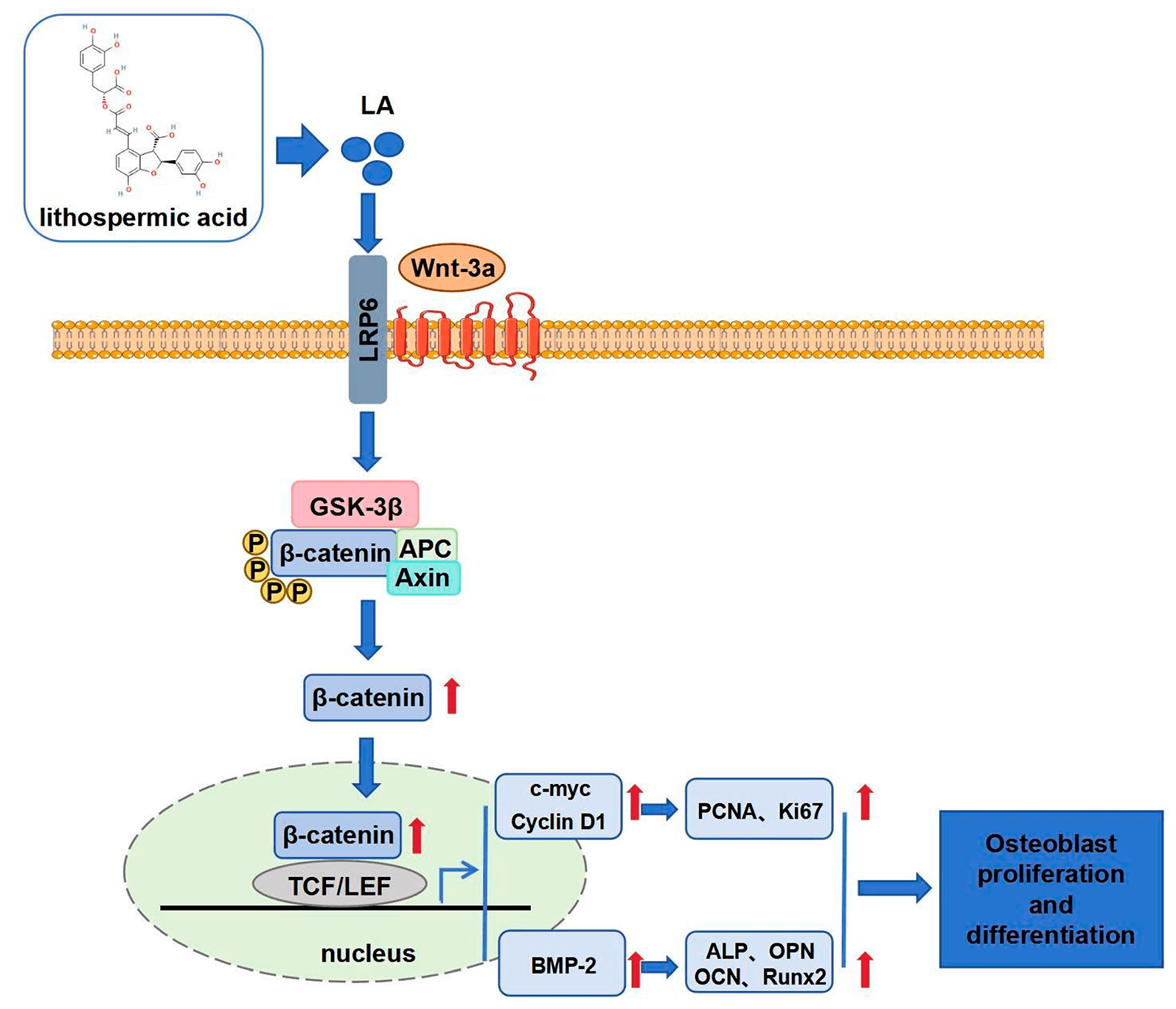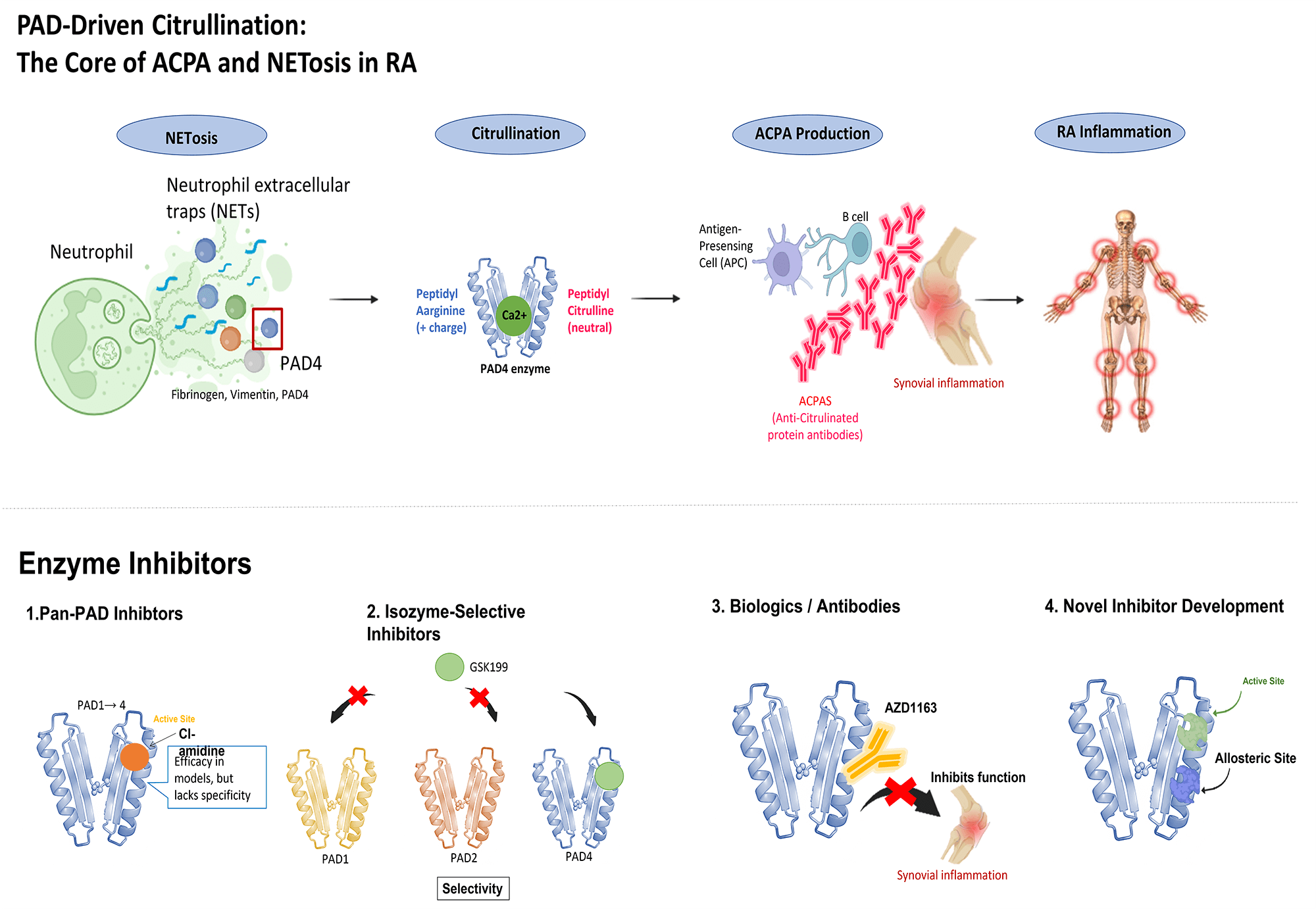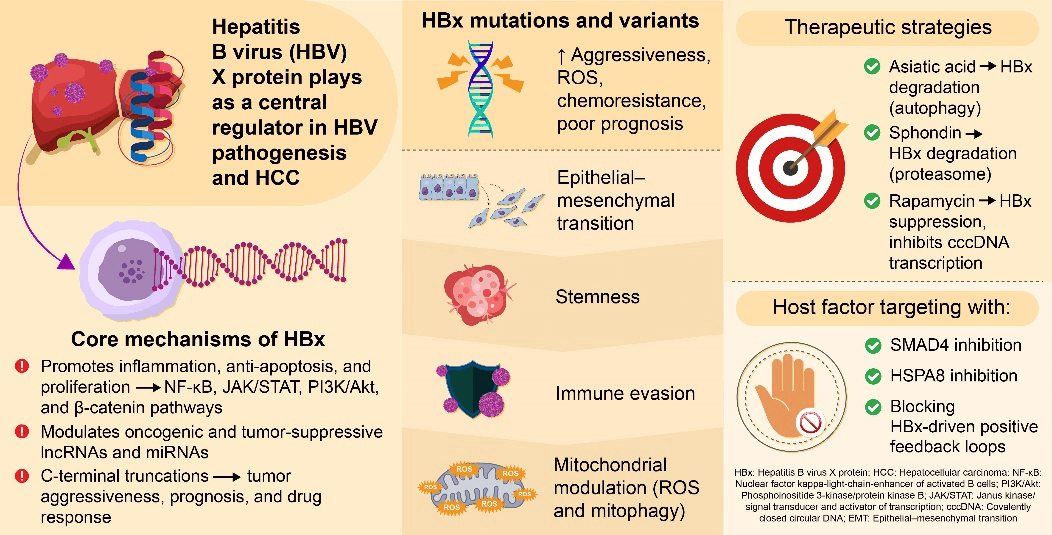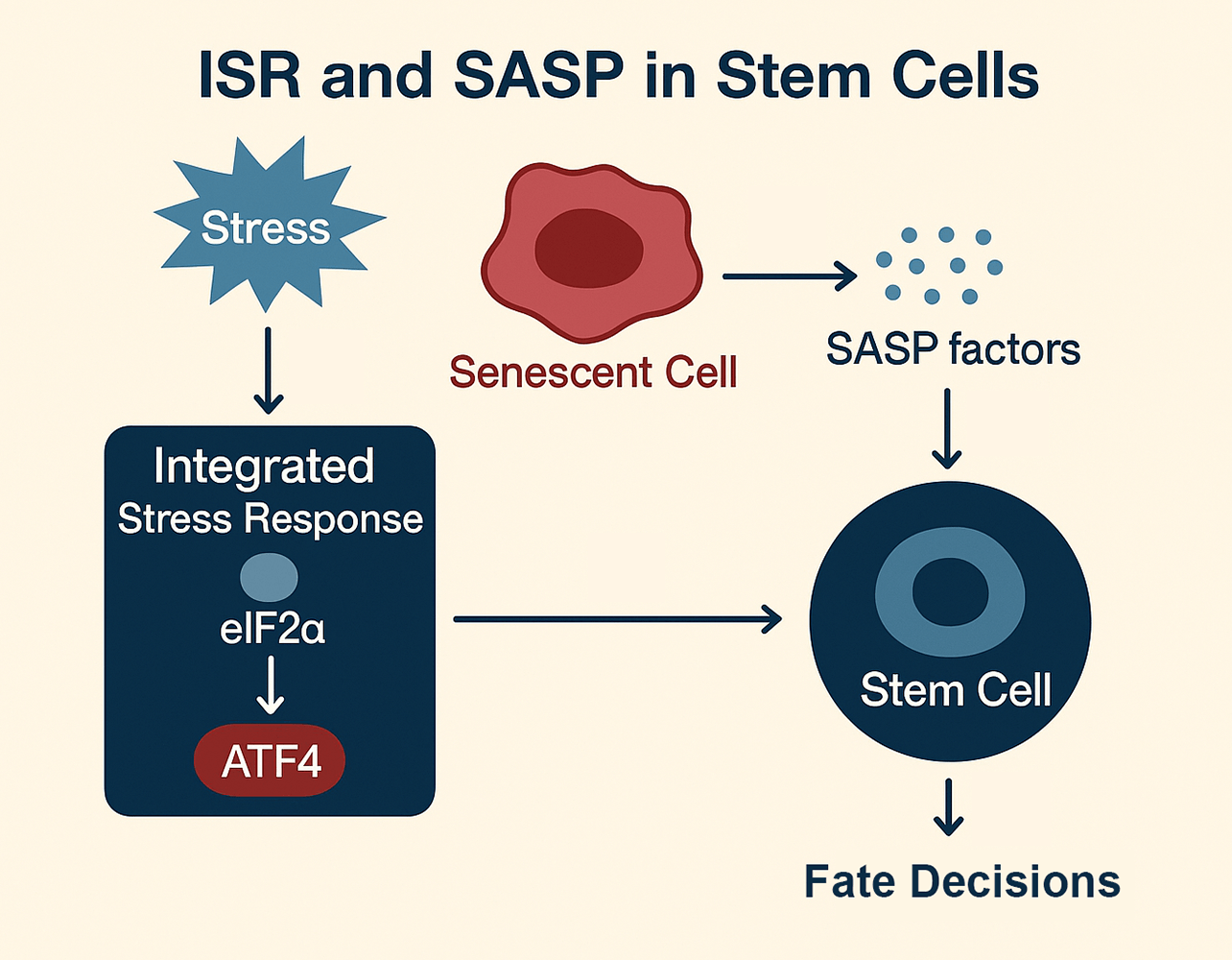 Open Access
Open Access
ARTICLE
Hang Zhang1,#, Meng-Yuan Chu1,#, Guohui Lv1, You-Jie Li1, Xuhang Liu2, Fei Jiao1,*, Yun-Fei Yan1,*
BIOCELL, DOI:10.32604/biocell.2025.068322
Abstract Objectives: Non-small cell lung cancer (NSCLC) remains a leading cause of cancer-related mortality, with limited understanding of lncRNA-driven mechanisms in tumor progression. This study aimed to identify differentially expressed lncRNAs in NSCLC tissues and elucidate the functional role of the significantly upregulated RP3-340N1.2 in promoting malignancy. Methods: RNA sequencing was used to screen dysregulated lncRNAs. RP3-340N1.2 was functionally characterized via gain/loss-of-function assays in NSCLC cells, assessing proliferation, migration, and macrophage polarization. Mechanisms of interleukin 6 (IL-6) regulation were explored using cytokine profiling, Actinomycin D assays, and RNA Immunoprecipitation (RIP) assays to study RP3-340N1.2 interactions with… More >
 Open Access
Open Access
ARTICLE
Przemysław Piwowarczyk1, Justyna Woś1, Agata Szymańska1, Sylwia Chocholska2, Waldemar Tomczak2, Jacek Roliński1, Agnieszka Bojarska-Junak1,*
BIOCELL, DOI:10.32604/biocell.2025.074128
(This article belongs to the Special Issue: The Role of γδ T Cells and iNKT Cells in Cancer: Unraveling Molecular Mechanisms and Therapeutic Potential)
Abstract Objectives: Chronic lymphocytic leukemia (CLL) is characterized by progressive immune dysregulation. Invariant natural killer T (iNKT) cells support immune surveillance, but the clinical relevance of their regulatory subsets remains unclear. FoxP3+ regulatory iNKT cells (iNKTreg) and E4BP4+IL-10+ (iNKT10) cells may reflect immunoregulatory changes associated with disease progression. The study aimed to quantify circulating iNKTreg and iNKT10 subsets and monocytic myeloid-derived suppressor cells (M-MDSCs) in treatment-naïve CLL patients and evaluate their associations with disease characteristics and time to first treatment (TTFT). Methods: Peripheral blood samples from 60 untreated CLL patients and 20 healthy donors were analyzed by… More >
 Open Access
Open Access
ARTICLE
Jianfeng Wang#, Zhongqing Hu#, Jiandong Guo, Xin Jin, Lei Cai, Jian Li, Jinxi Zhang*, DONGAN HE*
BIOCELL, DOI:10.32604/biocell.2025.072227
Abstract Objectives: Therapeutic strategies for enhancing bone regeneration and combating osteoporosis remain a significant unmet medical need. This study aims to elucidate Lithospermic acid (LA)’s regulatory effects on osteoblast proliferation and differentiation, investigating its viability as a bone-healing agent. Methods: This study employed various cellular and molecular biology experiments to assess the effects of LA on the viability, proliferation, cell cycle, apoptosis, differentiation, mineralization, and migration of MC3T3-E1 osteoblasts. Immunofluorescence and Western blot analyses were conducted to detect the expression of proteins related to the Wnt/β-catenin signaling pathway, investigating the regulatory mechanisms by which LA promotes… More >
Graphic Abstract

 Open Access
Open Access
REVIEW
YIWEI HAO1,#, YAODONG PING2,#, YAN YANG3, CHENG QU3, YUAN CHEN1, XUEYAN JIANG1, RONG FU1, HAILONG ZHAO4,*, LEI YU4,*
BIOCELL, DOI:10.32604/biocell.2025.074863
Abstract Myocardial ischemia, a core pathological process underlying diverse cardiovascular diseases such as coronary artery disease, poses a severe threat to global human health by frequently leading to acute myocardial infarction, heart failure, and even sudden cardiac death. A comprehensive understanding of its intricate underlying pathogenic mechanisms is not only crucial for developing effective therapeutic strategies but also essential for accelerating the translation of basic research findings into clinical practice. However, the complex regulatory networks that drive myocardial ischemia remain to be systematically clarified. These networks encompass the intricate interactions among multiple pathological processes, including energy… More >
 Open Access
Open Access
REVIEW
Yung-Chieh Huang1,2,3, Wen-Chien Cheng4,5, Ya-Hsuan Chao6, Tzu-Ting Chen7,*, Chi-Chen Lin8,9,10,11,*
BIOCELL, DOI:10.32604/biocell.2025.072732
(This article belongs to the Special Issue: Natural and Synthetic Small Molecules in the Regulation of Immune Cell Functions)
Abstract Protein arginine deiminases (PADs) are key enzymes in the development of rheumatoid arthritis (RA), catalyzing the conversion of arginine to citrulline in a process called citrullination. This post-translational modification is crucial to RA pathogenesis as it creates neo-antigens that trigger the production of anti-citrullinated protein antibodies (ACPAs). These ACPAs are highly specific to RA and often appear before clinical symptoms, making them valuable biomarkers for diagnosis and prognosis. Beyond ACPA production, PADs, particularly PAD4, play a vital role in forming neutrophil extracellular traps (NETs). NETs contribute to inflammation and joint damage, further highlighting the importance… More >
Graphic Abstract

 Open Access
Open Access
REVIEW
Alessio L. Ravani1, Michael I. Bukrinsky2, Anastasia V. Poznyak3,*
BIOCELL, DOI:10.32604/biocell.2025.074266
(This article belongs to the Special Issue: Molecular Basis for the Involvement of Inflammation and Lipids in Pathologies)
Abstract Atherosclerosis (AS) remains a major contributor to cardiovascular disease (CVD) mortality worldwide. Its development involves dysregulated lipid handling, persistent vascular inflammation, and endothelial cell (EC) dysfunction, influenced by genetic, environmental, and lifestyle factors. Increasing evidence highlights a pivotal role of endoplasmic reticulum (ER) stress as a molecular link between lipid dysregulation and inflammatory signaling in AS pathogenesis. ER stress is triggered by modified LDL, oxidized lipids, hyperhomocysteinemia, oxidative stress (OS), and disrupted calcium (Ca2+) homeostasis, leading to activation of the unfolded protein response (UPR). Core UPR mediators—inositol-requiring enzyme 1 (IRE1), protein kinase RNA-like ER kinase (PERK),… More >
 Open Access
Open Access
REVIEW
HUAN ZHOU1, JIAMI JIANG2, YUQING ZOU1, JIAHUI ZHANG1,*, ZHIWEI YU3,*
BIOCELL, DOI:10.32604/biocell.2025.073989
Abstract Obesity-related asthma is a distinct clinical phenotype, characterized by severe respiratory symptoms, reduced responsiveness to conventional glucocorticoid therapy, and a significantly increase in disease burden. With the rising global prevalence of obesity, the number of individuals affected by obesity-related asthma is steadily growing, presenting a pressing public health issue. The pathogenesis of obesity-related asthma is multifactorial, involving a complex interplay of metabolic and immune pathways. Key mechanisms include dysregulated T-cell differentiation, pro-inflammatory macrophage polarization, oxidative stress, and altered cytokines and adipokines secretion, all contributing to airway inflammation and remodeling. Additionally, metabolic factors, such as adiposity… More >
 Open Access
Open Access
ARTICLE
Egor A. Turovsky*, Elena G. Varlamova
BIOCELL, DOI:10.32604/biocell.2025.073728
(This article belongs to the Special Issue: MitoROS: Exploring Mitochondria and Oxidative Stress)
Abstract Objectives: Glioblastoma multiforme (GBM) is highly resistant to apoptosis. This study investigates the role of Selenoprotein M (SELENOM), a redox-regulating protein, in the response of human glioblastoma A-172 cells to staurosporine (STS) and hyperthermia. Methods: A stable SELENOM-knockdown (SELENOM-KD) cell line was created. We measured reactive oxygen species (ROS), mitochondrial membrane potential (ΔΨm), cell death, and apoptotic gene expression. Results: SELENOM-KD increased basal ROS levels and induced mitochondrial dysfunction. It sensitized cells to STS-induced apoptosis, enhancing the upregulation of pro-apoptotic genes. Conversely, under hyperthermia (42°C), SELENOM-KD cells exhibited significant thermoresistance, with 52% survival vs. 99% death More >
 Open Access
Open Access
ARTICLE
SHAOFENG XIONG1,2, WENKAI LV3, GUOSHENG CAO4, LONGSHENG FU1, WEN LIU3, MENGFAN LEI2, YANNI LV1,5,*
BIOCELL, DOI:10.32604/biocell.2025.073401
Abstract Objective: Leucine-rich alpha-2 glycoprotein 1 (Lrg1) could regulate diverse cells in cerebral ischemia-reperfusion. Our study seeks to uncover Lrg1’s impact on endothelial cell heterogeneity via differentiation pathways and transcription factors. Method: The CSOmap model measured cell-to-brain-center distances using single-cell RNA sequencing (scRNA-seq) data in middle cerebral artery occlusion reperfusion (MCAO/R). Monocle2 mapped endothelial differentiation paths. Gene set enrichment analysis (GSEA) analyzed endothelial subcluster variations. Database searches revealed a zinc finger MIZ-type containing 1 protein-frizzled 3 (Zmiz1-Fzd3) promoter interaction. Endothelial cells were transfected with a Fzd3 promoter-luciferase plasmid. Polymerase chain reaction (PCR) and western blotting assessed… More >
 Open Access
Open Access
REVIEW
Congwei You1,#, Anwen Yin2,#, Jia Xia3, Le Zhang4,*, Xiaolei Wang1,*, Yutong Hou4,*
BIOCELL, DOI:10.32604/biocell.2025.072971
Abstract Metabolic dysfunction-associated fatty liver disease (MAFLD) and chronic kidney disease (CKD) have shown a marked global increase in prevalence, placing a substantial burden on public health and healthcare systems worldwide. Epidemiological data demonstrate a significant overlap between these two conditions, with further evidence from research identifying common pathophysiological features, such as lipid metabolism dysregulation, disrupted energy balance, and chronic systemic inflammation. Mitochondria are central to the pathophysiology of both diseases. In addition to their role in energy production, mitochondria are involved in numerous critical cellular processes, including biosynthesis, lipid metabolism, oxidative phosphorylation, signal transduction, and More >
 Open Access
Open Access
ARTICLE
Zhitao Yang1,#, Huanyu Cheng1,#, Xinli Liu1, Jie Li1, Xin Ming1, Beibei Li1, Luyao Zhang1, Chunqing MA1, Yi Jiao1, Shenjia Wu1, Ibrar Muhammad Khan2, Guanghua Xiong1, Hongcheng Wang1,*, Yong Liu1,*
BIOCELL, DOI:10.32604/biocell.2025.072736
Abstract Objectives: Postmenopausal osteoporosis is the most common form of osteoporosis in clinical practice, affecting millions of postmenopausal women worldwide. Postmenopausal osteoporosis demands safe and effective therapies. This study aimed to evaluate the potential of hederagenin (Hed) for treating osteoporosis and to elucidate its underlying mechanisms of action. Methods: The anti-osteoporotic potential of Hed was assessed by investigating its effects on ovariectomy (OVX)-induced bone loss in mice and on receptor activator of NF-kappaB ligand (RANKL)-induced osteoclast differentiation in RAW264.7 cells. Network pharmacology analysis and molecular docking were employed to identify key targets, which were subsequently validated… More >
 Open Access
Open Access
REVIEW
Chung-Che Tsai1,#, Chih-Hung Lin2,#, Katherine Lin3,4, Jia Hong Hubert Chen4,5, Ying Jie Celia Chen4,5, Ilyssa Ting-Ying Chang3,4, Hsu-Hung Chang6, Jin-Yin Chang7, Tin-Yi Chu8, Po-Chih Hsu4,8,*, Chan-Yen Kuo8,*
BIOCELL, DOI:10.32604/biocell.2025.073698
Abstract Hepatocellular carcinoma (HCC) is a leading cause of cancer-related death worldwide, most commonly driven by chronic hepatitis B virus (HBV) infection. The HBV X protein (HBx) plays a central role in hepatocarcinogenesis by regulating transcription, signal transduction, epigenetic modification, and interactions with noncoding RNAs. This review summarizes current advances in HBx-mediated signaling pathways and mutation-specific functions, highlighting its potential as a prognostic biomarker and therapeutic target, and providing insights for future strategies in HCC treatment and HBV eradication. Activation of nuclear factor kappa-light-chain-enhancer of activated B cells (NF-κB), cAMP response element binding protein/activating transcription factor More >
Graphic Abstract

 Open Access
Open Access
REVIEW
KAWALJIT KAUR*
BIOCELL, DOI:10.32604/biocell.2025.073340
(This article belongs to the Special Issue: Novel Targeted Therapy in Oncology)
Abstract Diffuse intrinsic pontine glioma (DIPG) is a pediatric brainstem tumor with a very poor prognosis, characterized by immunosuppressive tumor microenvironment (TME) that limits immune infiltration, including a significant reduction in circulating natural killer (NK) cells. This drop in NK cell levels and activity may promote tumor growth and immune evasion, making NK cells a promising target for immunotherapy. NK cells can attack and eliminate DIPG tumor cells, including glioma stem cells, while counteracting certain immune evasion strategies. Although the DIPG microenvironment and blood-brain barrier present challenges, NK cell-based therapies have shown encouraging tumor control and… More >
 Open Access
Open Access
REVIEW
ANNA PAWłOWSKA-ŁACHUT*, DOROTA SUSZCZYK, IWONA WERTEL
BIOCELL, DOI:10.32604/biocell.2025.072104
(This article belongs to the Special Issue: The Role of γδ T Cells and iNKT Cells in Cancer: Unraveling Molecular Mechanisms and Therapeutic Potential)
Abstract Ovarian cancer (OC) remains the most lethal gynecological malignancy, and it is characterized by high heterogeneity, early metastatic dissemination, and frequent recurrence within 12–18 months after primary therapy. Despite progress in clinical management and drug development, the mortality rate remains high, and the biological drivers of OC aggressiveness are not fully understood. A major contributor to therapeutic resistance and disease progression is the ovarian tumor microenvironment (TME), which supports tumor growth and immune evasion. Its complexity poses significant challenges to the development of effective therapies. Current treatments, especially in advanced or recurrent stages, have limited… More >
 Open Access
Open Access
REVIEW
JOONGBUM MOON1, JI HYEON AHN2, MOO-HO WON3,*
BIOCELL, DOI:10.32604/biocell.2025.072635
(This article belongs to the Special Issue: Cellular and Molecular Insights into Brain Ischemic Insults)
Abstract Ischemia-reperfusion (I/R) injury induces region-specific neuronal vulnerability within the hippocampus, with the cornu ammonis 1 (CA1) subfield particularly prone to delayed neuronal death. While intrinsic neuronal factors have been implicated, emerging evidence highlights the decisive contribution of astrocyte endfeet (AEF)—specialized perivascular structures that regulate ion and water homeostasis, glutamate clearance, and blood–brain barrier (BBB) stability. This review synthesizes structural and molecular alterations of AEF across the CA1–CA3 subfields following I/R and their correlation with neuronal fate. In CA1, AEF undergo early-onset swelling and detachment from the vascular basal lamina due to dysfunction of critical proteins… More >
 Open Access
Open Access
REVIEW
George Anderson*
BIOCELL, DOI:10.32604/biocell.2025.073221
(This article belongs to the Special Issue: Melatonin and Mitochondria: Exploring New Frontiers)
Abstract As natural killer (NK) cells eliminate cancer cells and virus-infected cells, as well as modulate various other medical conditions, including aging-associated conditions such as neurodegenerative disorders, understanding NK cell regulation is of considerable clinical importance. This article reviews the role of circadian processes (melatonin and the cortisol system), aryl hydrocarbon receptor, and vagal nerve in the modulation of NK cell function, highlighting the importance of the endogenous mitochondrial melatonergic pathway in NK cells. As circadian and exogenous melatonin increase NK cell cytotoxicity, the presence of the endogenous melatonergic pathway may be of some importance not… More >
 Open Access
Open Access
REVIEW
Chanu Lee, Suhyun Che, Jea-Hyun Baek*
BIOCELL, DOI:10.32604/biocell.2025.073551
(This article belongs to the Special Issue: The Role of γδ T Cells and iNKT Cells in Cancer: Unraveling Molecular Mechanisms and Therapeutic Potential)
Abstract The paradigm of cancer treatment has been reshaped by chimeric antigen receptor (CAR) αβ T cell therapy, yet its full potential remains constrained by fundamental limitations. While conventional CAR αβ T cells have achieved notable success in hematological malignancies, their broader application is hindered by the high cost and delays of autologous manufacturing, as well as the critical risk of graft-vs-host disease (GvHD). In addition, their efficacy against solid tumors is often compromised by the immunosuppressive tumor microenvironment (TME). As a promising solution, γδ T cells are being developed as an alternative CAR platform. Their… More >
 Open Access
Open Access
ARTICLE
Zongmeng Zhang1,2,#, Cai Chen3,#, Shaorui Rui3, Conghan Li3, Jiong Gu3,*, Liang He3,*
BIOCELL, DOI:10.32604/biocell.2025.073085
Abstract Objective: Hepatocellular carcinoma (HCC) ranks among the most prevalent malignant tumors globally. Metabolically associated fatty liver disease is a significant risk factor for HCC. Adiponectin, a key regulatory protein in glucolipid metabolism, presents potential as an anti-tumor target in HCC cells. The study focused on evaluating the anti-HCC properties of AdipoRon, an agonist of the adiponectin receptor. Method: Cell viability and proliferation were assessed using the cell counting kit-8 and colony formation assays, respectively. AdipoRon’s effect on HCC cell damage was evaluated via flow cytometry, apoptosis, and (lactate dehydrogenase) LDH assays. Mitochondrial function was evaluated… More >
 Open Access
Open Access
REVIEW
YATING WEI1, HONGKANG YAO1, XIAN SHI2, HONG CHEN3, RONGZONG YE4,*, CHAOQIAN LI1,*
BIOCELL, DOI:10.32604/biocell.2025.072780
(This article belongs to the Special Issue: Advanced Cell Signaling Pathways in Health and Disease)
Abstract Atherosclerosis, characterized by the formation of fibrofatty lesions in the arterial wall, remains a leading cause of global morbidity and mortality. Emerging evidence highlights the critical regulatory roles of long non-coding RNAs (lncRNAs) and microRNAs (miRNAs) in atherogenesis. LncRNAs can function as competing endogenous RNAs (ceRNAs) by sponging miRNAs, thereby modulating the expression of downstream target mRNAs. This review summarizes current knowledge on lncRNA-miRNA-mRNA regulatory networks and their functional roles in the three major cell types involved in atherosclerotic plaque development: endothelial cells (ECs), vascular smooth muscle cells (VSMCs), and macrophages. In ECs, these networks More >
 Open Access
Open Access
REVIEW
Silvia Carloni1,*, Maria Gemma Nasoni1, Serafina Perrone2, Erik Bargagni1, Carla Gentile3, Walter Manucha4, Russel J. Reiter5, Francesca Luchetti1,*, Walter Balduini1,*
BIOCELL, DOI:10.32604/biocell.2025.073776
(This article belongs to the Special Issue: Melatonin and Mitochondria: Exploring New Frontiers)
Abstract Mitochondria are central regulators of cellular energy metabolism, redox balance, and survival, and their dysfunction contributes to neurodegenerative, cardiovascular, and metabolic diseases, as well as aging. Beyond its role as a circadian hormone, melatonin is now recognized as a key modulator of mitochondrial physiology. This review provides an overview of the mechanisms by which melatonin can preserve mitochondrial function through multifaceted mechanisms. Experimental evidence shows that melatonin enhances the activity of electron transport chain (ETC) complexes, stabilizes the mitochondrial membrane potential (Δψ), and prevents cardiolipin (CL) peroxidation, thereby limiting permeability transition pore (mPTP) opening and… More >
 Open Access
Open Access
REVIEW
Antonio Magan-Fernández1, Sarmad Muayad Rasheed Al-Bakri1, Marco Bonilla2,*, Francisco Mesa1
BIOCELL, DOI:10.32604/biocell.2025.073576
(This article belongs to the Special Issue: NETs: A Decade of Pathological Insights and Future Therapeutic Horizons)
Abstract Objectives: Neutrophil extracellular traps (NETs) have emerged as critical effectors in immune defense but also as potential drivers of tissue damage in chronic inflammatory diseases. Their role in periodontitis, a highly prevalent condition characterized by dysregulated host–microbe interactions, remains incompletely defined. This systematic review aimed to synthesize, for the first time, ex vivo human evidence on the presence, activity, and clinical significance of NETs in periodontitis. Methods: A comprehensive search of Medline, Web of Science, and Scopus was conducted up to August 2025. Eligible studies included ex vivo human investigations assessing NETs or NET markers in gingival… More >
 Open Access
Open Access
REVIEW
Gizem Kaynar Beyaz1,*, Ahmet Kirbas2, Sevgi Kalkanli Tas1
BIOCELL, DOI:10.32604/biocell.2025.072368
(This article belongs to the Special Issue: Mechanisms Driving COPD, Atherosclerosis, and Cardiovascular Disease: From Pathogenesis to Therapeutic Innovations)
Abstract Peripheral artery disease (PAD) remains a significant global health issue, with current treatments primarily focused on relieving symptoms and addressing macrovascular issues. However, critical immunoinflammatory mechanisms are often overlooked. Recent evidence suggests that monocyte phenotypic plasticity plays a central role in PAD development, affecting atherogenesis, plaque progression, ischemia-reperfusion injury, and chronic ischemic remodeling. This narrative review aims to summarize the latest advances (2023–2025) in understanding monocyte diversity, functional states, and their changes throughout different stages of PAD. We discuss both established and emerging biomarkers, such as circulating monocyte subset proportions, functional assays, immune checkpoint expression, More >
 Open Access
Open Access
ARTICLE
Luis Felipe HernáNdez-Ayala1, Russel J. Reiter2, Annia Galano1,*
BIOCELL, DOI:10.32604/biocell.2025.071635
(This article belongs to the Special Issue: Melatonin and Mitochondria: Exploring New Frontiers)
Abstract Objectives: Oxidative stress (OS) plays a pivotal role in chronic and neurodegenerative diseases, which has sparked interest in molecules that modulate redox-regulating enzymes. Melatonin and its metabolites exhibit antioxidant properties; however, their molecular mechanisms of enzymatic and transcriptional modulation remain unclear. This study aimed to investigate, through an exploratory in silico approach, the interactions of melatonin and related compounds with OS-related enzymes to generate hypotheses about their role in cellular redox control. Methods: A rational selection of antioxidant, pro-oxidant, and transcriptional targets was performed. Ligands were optimized at the DFT level (M05-2X/6-311+G(d,p)) and docked to OS… More >
 Open Access
Open Access
REVIEW
Kawaljit Kaur*
BIOCELL, DOI:10.32604/biocell.2025.073252
(This article belongs to the Special Issue: The Role of γδ T Cells and iNKT Cells in Cancer: Unraveling Molecular Mechanisms and Therapeutic Potential)
Abstract Gamma delta (γδ) T cells and invariant natural killer T (iNKT) cells are unconventional T cells with limited T cell receptor (TCR) diversity. Both can recognize lipid or non-peptide antigens, often through cluster of differentiation 1d (CD1d), rapidly produce cytokines, express natural killer (NK) cell markers, and are mainly found in mucosal and barrier tissues. Acting as a bridge between innate and adaptive immunity, they show great promise for cancer immunotherapy. Developing γδ T and iNKT cells for treatment involves shared features like thymic origin, MHC-independent recognition, rapid cytotoxicity, low graft-vs.-host disease (GvHD) risk, ex vivo… More >
 Open Access
Open Access
REVIEW
Mayuri Shukla1, Soraya Boonmag2, Parichart Boontem1, Piyarat Govitrapong1,*
BIOCELL, DOI:10.32604/biocell.2025.072557
(This article belongs to the Special Issue: Melatonin and Mitochondria: Exploring New Frontiers)
Abstract Ischemic stroke is one of the major causes of long-term disability and mortality worldwide. It results from an interruption in the cerebral blood flow, triggering a cascade of detrimental events like oxidative stress, mitochondrial dysfunction, neuroinflammation, excitotoxicity, and apoptosis, causing neuronal injury and cellular death. Melatonin, a pleiotropic indoleamine produced by the pineal gland, has multifaceted neuroprotective effects on stroke pathophysiology. Interestingly, the serum melatonin levels are associated with peroxidation and antioxidant status, along with mortality score in patients with severe middle cerebral artery infarction. Melatonin exhibits strong antioxidant, anti-inflammatory, and anti-apoptotic properties and preserves More >
 Open Access
Open Access
REVIEW
SEUNGIL KIM, GUN-DONG KIM*
BIOCELL, DOI:10.32604/biocell.2025.073781
(This article belongs to the Special Issue: NETs: A Decade of Pathological Insights and Future Therapeutic Horizons)
Abstract Neutrophil extracellular trap (NET) formation or NETosis is a specialized innate immune process in which neutrophils release chromatin fibers decorated with histones and antimicrobial proteins. Although pivotal for pathogen clearance, aberrant NETosis has emerged as a critical modulator of acute and chronic respiratory pathologies, including acute respiratory distress syndrome, asthma, and chronic obstructive pulmonary disease. Dysregulated NET release exacerbates airway inflammation by inducing epithelial injury, mucus hypersecretion, and the recruitment of inflammatory leukocytes, thereby accelerating tissue remodeling and functional decline. Mechanistically, NETosis is governed by peptidyl arginine deiminase 4 (PADI4)-mediated histone citrullination, NADPH oxidase-dependent reactive More >
 Open Access
Open Access
REVIEW
Douglas M. Ruden*
BIOCELL, DOI:10.32604/biocell.2025.072273
(This article belongs to the Special Issue: Cellular Senescence in Health and Disease)
Abstract Stem cell fate decisions are increasingly understood through the dynamic interplay of two fundamental stress-adaptive programs: the integrated stress response (ISR) and the senescence-associated secretory phenotype (SASP). These pathways act as a Yin–Yang system, balancing beneficial and detrimental outcomes across development, tissue homeostasis, and disease. On the yin (protective) side, transient ISR activation and acute SASP signaling foster adaptation, embryonic patterning, wound healing, and regeneration. On the yang (maladaptive) side, chronic ISR signaling and unresolved SASP output drive stem cell exhaustion, fibrosis, inflammation, and tumorigenesis. This duality highlights their roles as both guardians and disruptors More >
Graphic Abstract

 Open Access
Open Access
TOSHIYUKI HABU*
BIOCELL, DOI:10.32604/biocell.2025.071798
(This article belongs to the Special Issue: Advanced Cell Signaling Pathways in Health and Disease)
Abstract RING protein 213 (RNF213), the susceptibility gene for Moyamoya disease (MMD), possesses two active AAA+ ATPase (ATPases Associated with diverse cellular Activities) modules, a RING, and RNF213-ZNFX1 finger (RZ finger) domains. Several RNF213 variants have been reported in MMD patients, including the p.R4810K variant (rs112735431), which is a founder polymorphism associated with MMD in East Asia. To elucidate the function of RNF213 and its variant, we investigated the localization of RNF213 and the R4810K variant in this study. RNF213 induced circular hole structures near the nucleus, similar to lipid droplets (LDs), in U-2 OS cells. More >
 Open Access
Open Access
REVIEW
JOSé A. BOGA1,2, ANA COTO-MONTES2,3,*, RUSSEL J. REITER4
BIOCELL, DOI:10.32604/biocell.2025.068245
(This article belongs to the Special Issue: Melatonin and Mitochondria: Exploring New Frontiers)
Abstract Aerobic glycolysis, also known as the Warburg effect, and the accumulation of lactate that it causes, are increasingly recognized outside the field of oncology as triggers of chronic non-neoplastic disorders. This review integrates preclinical and clinical evidence to evaluate the ability of melatonin to reverse Warburg-effect-like metabolic reprogramming. Literature on neurodegeneration, age-related sarcopenia, type 2 diabetes, chronic kidney disease, heart failure and pulmonary arterial hypertension (PAH) has been reviewed and synthesised. In all of these conditions, hypoxia-inducible factor 1α (HIF-1α) and pyruvate dehydrogenase kinase 4 (PDK4) inhibit the pyruvate dehydrogenase complex. This diverts pyruvate away… More >
 Open Access
Open Access
REVIEW
Rasit Dinc1, Nurittin Ardic2,*
BIOCELL, DOI:10.32604/biocell.2025.072337
(This article belongs to the Special Issue: NETs: A Decade of Pathological Insights and Future Therapeutic Horizons)
Abstract Neutrophil extracellular traps (NETs) have emerged as key mediators of cardiovascular diseases (CVDs), linking innate immune activation to vascular injury, thrombosis, and maladaptive remodeling. This review synthesizes recent insights into the molecular and cellular pathways driving NET formation, including post-translational modifications, metabolic reprogramming, inflammasome signaling, and autophagy. It highlights the role of NETs in atherosclerosis, thrombosis, myocardial ischemia-reperfusion injury, and hypertension, emphasizing common control points such as peptidylarginine deiminase 4 (PAD4)-dependent histone citrullination and nicotinamide adenine dinucleotide phosphate oxidases 2 (NOX2)-mediated oxidative stress. Mechanistic interpretation of circulating biomarkers, including myeloperoxidase (MPO)-DNA complexes, citrullinated histone H3,… More >